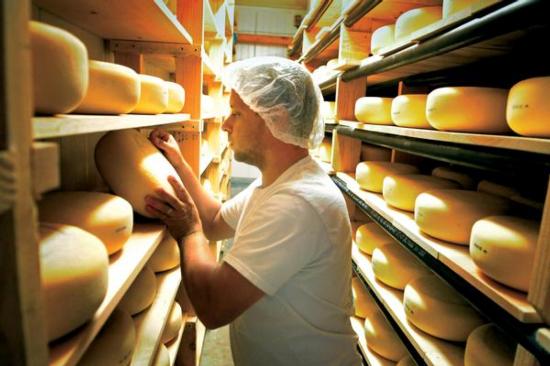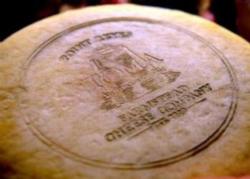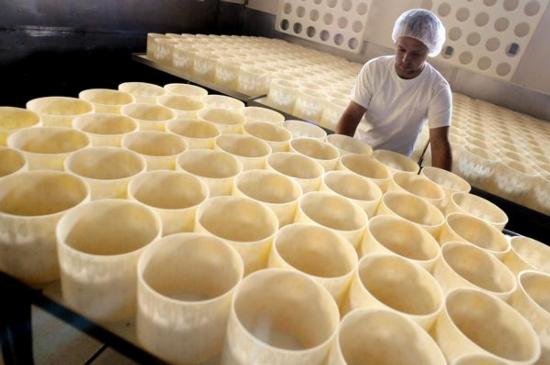Mature at last, Marin County's cheeses stand alone
Rob Rogers Marin IJ
link to article: http://www.marinij.com/ci_15725747
August 10, 2010

There are those who say Marin County's Cheese Renaissance began on July 7, when Point Reyes Original Blue was crowned "Best of Show" at the California State Fair.
Then there are those who say the renaissance began five years earlier, when the Marin French Cheese Co.'s Rouge et Noir Triple Creme Brie took top honors at the World Cheese Awards in London.
"When Marin French won an award for brie in a European contest, it was the equivalent of when (Napa Valley's ) chardonnay won in Europe and put California on the map," said Lynne Deveraux, director of the annual California Artisan Cheese Festival. "It finally brought American cheeses into the international arena."
"You can make bad cheese from good milk, but you will never make great cheese with bad milk. It's just not possible," said Michael Zilber, general manager of Cowgirl Creamery. "We are lucky to have some superb sources of milk. I think the salt air, great grass and conscientious animal husbandry practices going on out here make for good cheese."
"A lot of the dock workers were European, and for breakfast they'd eat pickled eggs and drink beer," said company President Maxx Sherman. "The Thompsons thought they'd try feeding them cheese - a fresh curd breakfast cheese, which could be made quickly."
Almost every cheese now made in Marin has its origins in Europe: Cowgirl Creamery uses Dutch techniques; the new Nicasio Valley Cheese Co. draws on the Italian Swiss heritage of its owners, the LaFranchi family; and the Barinaga Ranch specializes in Basque sheep cheeses.

Over time, however, Marin's conditions and techniques have given those cheeses a distinctly American interpretation. That's particularly true at Point Reyes' Cowgirl Creamery, where local air and soil conditions helped create one of the company's best-known cheeses by accident.
"Our Red Hawk cheese initially has a fluffy white mold growing on it," Zilber said. "In the process of washing our cheese with brine, we introduced some naturally occurring bacteria that's in the air here - and that bacteria gives the cheese its pungent, stinky quality. We can't produce Red Hawk in our new facility in Petaluma, because it exists in the air in that concentration only in Point Reyes."
By using only organic milk from the nearby Straus Family Creamery, Cowgirl founders Sue Conley and Peggy Smith gave the company a reputation for consistency and greater control over the quality of their product. The same desire for control over every aspect of the cheesemaking process inspired the Giacomini family of Point Reyes Station, who created the first version of Point Reyes Original Blue in 2000 as a "farmstead" cheese.
"What 'farmstead' means is that we use only our milk, from our own herd of animals that live right on the property where our cheese is made," said Jill Giacomini Basch, managing partner for the Point Reyes Farmstead Cheese Co. and one of four Giacomini daughters to take over management of the dairy from her father, longtime Point Reyes dairyman Robert Giacomini.
"The first 40 years of this dairy's existence was all about producing milk and seeing it trucked away every morning to the local creamery," Basch said. "My father always wished he had the ability, time and energy to put forward making the finished product himself."
Making and selling cheese has helped farm families like the Giacominis survive the recent upheavals in the dairy industry. Yet turning a dairy farm into a cheesemaking facility requires a considerable investment of time and money, said Marin Agricultural Commissioner Stacy Carlsen.
"It's exciting and very rewarding, but it requires a business plan and exceptional skills to get the product to market," he said.
While he's pleased by the strides Marin's cheesemakers have made in recent years, Carlsen is quick to play down the notion that Marin County could someday be to cheese what Napa and Sonoma counties are to wine. Instead, Carlsen hopes both consumers and Marin residents come to see the value in the kind of agricultural traditions that allowed those cheeses to develop.
"I wouldn't want to see us as just a cheese region, but as a region that creates all the products associated with grass-based agriculture: premier organic vegetables, grass-fed beef and cheese," Carlsen said.
But turning the county into one of the world's centers for cheese is exactly what Rick LaFranchi has in mind. Six months or so after his family's Nicasio Valley Cheese Co. debuted its products - to rave reviews - LaFranchi says he's finally ready to place his cheeses before their toughest critics: the residents of the Swiss village of Maggia, which his family left more than a century ago and to which he and his siblings returned to learn the arts of cheese.
"I think there's a real interest here in fine cheeses, and I think the cheesemakers of our area are absolutely the best," LaFranchi said. "We are developing a world-class product. That's the goal."

Cheesemaker Kuba Hemmerling stands at a table
of cheese molds cleaned and ready for the next batch
of cheese at the Point Reyes Farmstead Cheese Company
(IJ photosJeff Vendsel
Which cheeses deserve to stand alone? The experts weigh in.
- Toma, Point Reyes Farmstead Cheese Co.: "We got our first shipment two months ago, and have not been able to keep it on the shelves," said Gordon Edgar, author of "Cheesemonger: A Life on the Wedge."
"You will fall in love with it. There's nothing you can't love about that cheese," said Lynne Deveraux, director of the California Artisan Cheese Festival.
- Mount Tam, Cowgirl Creamery: "That's the cheese I would take to a desert island with me," Deveraux said.
- Rouge et Noir Schloss, Marin French Cheese Co.: "It's an underrated cheese, right up there with Liederkranz and Limburger in terms of a stinky, strong cheese," Edgar said.



